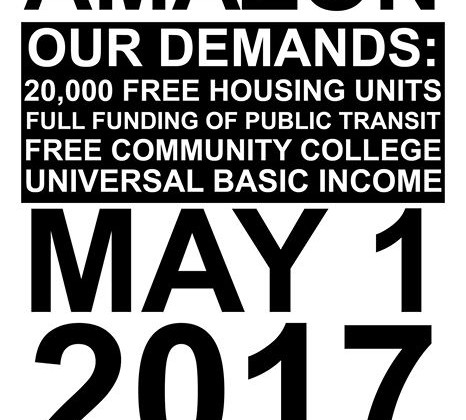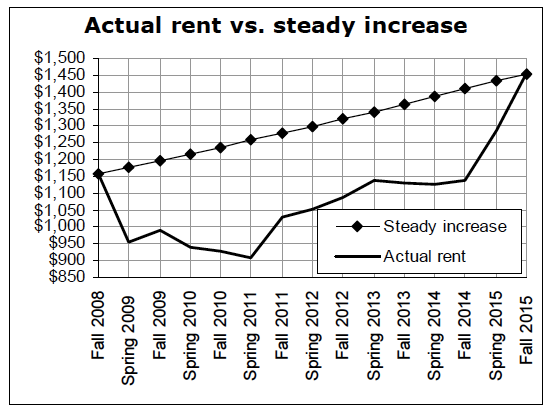March on Amazon? Maybe it’s Not Such a Bad Idea!
So the flier in the featured image of this post has been showing up on line lately. Here’s the details from a Facebook post:
On May 1st, 2017, we are calling on all interested and affected parties to converge on Westlake Park to march on Amazon HQ in South Lake Union. We will rally at 11 AM and march at noon to deliver four demands to Amazon and its CEO:
-20,000 fully subsidized and perpetually free public housing units. These units will be given to those who actually need them. This will solve the homeless problem in King County.
-Full funding of King County Metro, Sound Transit, and Community Transit so that everyone in the region has free transportation. This will actually decrease car use.
-Free community college for everyone in King County. This will ensure everyone has an advanced education.
-Universal basic income for every resident of King County (at least 1,000.00 USD per month). This will ensure that everyone has their basic needs meet.
We encourage all those who support these demands to attend, either as a group or as individuals.
With Seattle drifting more and more to the left everyday I’m starting to think the ideas behind this march aren’t so bad. Think about it, if Amazon built 20,000 free units of housing, maybe we could convince the Mayor and Council to end the shake down of market rate housing development through Mandatory Inclusionary Zoning to fund price non-profit affordable housing. Full funding of transit means sales and property taxes that fund those services could be eliminated; think of the savings to construction costs and to renters who pay property tax through rent increases. Free college? Why not? More money to offset “skyrocketing” rents! And of course I support universal income already.
So on May 1 you might see me with a red bandana and a big sign with these demands. I mean I can’t hurt to ask, right?
Sightline Corroborates Our Message….Again!
Dan Bertolet at the Sightline Institute has delivered his promised post on the impact of Mandatory Inclusionary Zoning (MIZ) on low-rise zones in the city. The news is what we’ve been saying a million times: MIZ won’t work and will actually make prices for housing in Seattle worse, not better.
Indeed, my previous case studies of mid-rise and high-rise upzones found that MHA as proposed —and now implemented in the University District—is so poorly balanced that it would slash builders’ return on investment and suppress homebuilding. Disappointingly, it’s a similar story for the low-rise apartments I analyze here: the draft low-rise MHA policy is imbalanced and will slow construction and produce less housing—subsidized and market-rate—as a consequence. And less housing means more competition for what’s available, rising rents, and more displacement of low-income families and individuals.
MHA’s financial hit on low-rise homebuilding would be less severe than what my previous analysis indicated for mid-rise and high-rise examples. But most low-rise housing is built by small businesses that have less tolerance for added costs than the larger companies that build mid- and high-rise apartments. MHA as currently proposed would not only undermine Seattle’s goals to build more affordable homes for low-income residents, but also the city’s goals to create a full spectrum of housing choices for all.
Ironically, the conceptual heart of the grand Grand Bargain itself is an impediment to the kind of cultural shift necessary to garner political support for upzones. The problem is that because the bargain sanctions a trade-off between upzones and affordability, it perpetuates the widely held misconception that allowing increased housing density is a necessary evil at best. But the truth couldn’t be any more opposite—the positive effect on affordability in particular, not to mention reduced sprawl and greenhouse gas emissions, along with improved human health and productivity.
We used Loan to Value Ratio (LRV) in my analysis of a townhouse project. I think it’s a better way to show the loss of return on investment because it’s what lenders use. You can also use Debt to Credit Ratio (DCR). And, sure, the harm is lost production. But it’s worse than that: higher prices will have to cover the out of balance LRV. When a project can’t promise to deliver at least about 20 cents on the dollar of cash flow, the project won’t get financing. There are ways to fix the ratio.The City has long ago concluded “the value of land will go down and so will the price,” so don’t worry, they say, prices won’t go up the greedy land seller will take the hit. The problem is that isn’t how real markets work. We’ve seen this land market actually doing the OPPOSITE now, with sellers wanting MORE since their dirt is in a higher zone.
Next up? Rent control. Although the Council has been doing that is slow motion.
Taken together with all the other regulatory overreach we are well in our way to being the Bay Area. And this is how we’re “fixing” high prices. I’ve never seen a group of people so determined to do exactly the wrong thing, over, and over, and over again. Sad!
Charts and Graphs: More Taxes Mean Higher Rents
Part 3. The Price of Love: Housing, Economics, Politics, Money, and Being Loved
When I was in elementary school I took some pleasure in telling other kids on the playground that Santa Claus didn’t exist. I remember the look on their faces, the fear and disappointment. Then I saw the furrowing brow and anger. They knew Santa was a hoax. But as long as believing in him and colluding with the parental story about where the presents under the tree came from meant presents, then why challenge it? The myth was working for them. Of course this didn’t make me popular or loved by my colleagues.
The same kind of collusion is going on in Seattle when it comes to housing. And unlike my hapless playground victims who suffered what I hope was an early encounter with their conscience, real damage and hurt is being done to real people with the City’s blind pursuit of more units with no vision about how we should define and address housing needs in our growing city. A big part of our problem around here is the breathless and desperate need people in the sphere of Seattle political discourse need to be liked.
Let’s go back to economics for a minute. We don’t need to debate and argue about what high prices mean. We know that high prices mean that more people want housing than is available. But what makes otherwise smart, educated, talented, and accomplished people agree to tax the production of new housing to meet the arbitrarily set unit goal? The answer is a combination of politics, money, and the need to be liked.
In 1986 the Reagan administration created a program called the Low Income Housing Tax Credit program or LIHTC (pronounced Lie Tech). The LIHTC was intended to incentivize multifamily construction that had been lagging, and apartments were seen as a lower cost option for many families.
What ensued in Washington State and in Seattle in particular was the development of an industry around the tax credit model of financing low-income housing. The way it works is that local leverage and bank loans are used to capture dollars from private investors who get a credit against their corporate taxes. Along with an almost dollar for dollar credit, the private investor also gets the benefit of at least a decade of depreciation on the construction of a low-income housing project, provided that the project rents to people earning 60 percent of AMI or less.
Smart people figured out how to turn this crank, and part of it was building, over decades, strong political connections with local and state elected officials. These smart folks created non-profit housing organizations, found land, used local government grants and loans from banks looking to meet their Community Reinvestment Act (CRA) obligations, and built housing projects to meet the needs of households struggling with poverty.
So far so good. I must say here, that I was a non-profit housing director for one project. I also believe in the concept of leveraging private investment and capitol to benefit people and families struggling with poverty. In fact, I don’t think there is any other way to end generational poverty than to create a growing economy that provides incentives and opportunities and encouragement and resources to people who are poor so that they can earn more money. I don’t think anyone is entitled to be rich or to be poor. Subsidized housing can be part of the pathway from economic bondage to choice, freedom and unleashing the creativity and productivity.
But over the years, the non-profit housing builders have accumulated tremendous political power. The current Speaker of the Washington State House of Representatives is one of the early pioneers of non-profit housing development. The Chair of the Mayor’s Housing Affordability and Livability Agenda (HALA) Committee Faith Pettis runs a for-profit law firm that acts as the lawyer for the Washington State Housing Finance Commission (WSHFC), an organization that grants tax credits. My project paid her firm significantly and one non-profit developer told me her firm collected $60,000 in fees at closing of his project.
Not a single newspaper or reporter has commented or written that some of the fees associated with Mandatory Inclusionary Zoning (MIZ) will find their way into Pettis’ pockets. When I asked the Seattle Ethics and Elections Committee whether Pettis had to disclose this conflict they said she didn’t. Imagine if a well-known attorney representing for-profit developers was a chair of the HALA Committee? The headlines would have been Pearl Harbor sized.
I asked Mike Baker at the Seattle Times to report on this and he’s declined. I also sent a message to Danny Westneat, a columnist at the Times. He didn’t respond. I had forgotten that Weastneat’s wife works for Mercy Housing, a huge producer of non-profit housing. I guess we won’t be seeing a screed from Westneat anytime soon on the high costs of non-profit affordable housing.
I could name more names and associations, but the fact is that the non-profit housing producers have a lock on Seattle and state politics and the press. Their business is producing units, sometimes as in Pettis case, for a profit. And in Westneat’s case, the association is so close how could he challenge the machine. So is it any wonder that the Mayor and Council have proposed a scheme that would tax the production of new market rate housing development to produce money that would funnel into non-profit housing development?
I’ve already pointed out that non-profit tax credit housing is far more expensive that market rate housing. Really, really expensive; Capitol Hill Housing produced 88 units for $47 million. Everyone agrees this is an extraordinarily expensive project by any standard.
This is all a vicious circle. We regulate land use and the building of housing in a way that produces the high prices we have. Through zoning, design review, infrastructure requirements, taxes, fees, other rules, regulations, and the slowness of the permitting process we slow the production of housing, limit the number of units possible, and add costs. All of these things mean higher prices.
The City Council and Mayor turn up the regulatory dial to protect the equity of single-family incumbent homeowners, and then prices go up. As a red herring, incumbents yell about price. Seattle politicians respond by dialing up regulation, ensuring higher prices.
Non-profits show up saying they’ll produce affordable units. Remember the number of units is our measure of success in combating the “crisis,” right? The cost to build housing is now as high as $500,000 a unit, and that is extremely inefficient. Much of that cost is transaction costs charged by lawyers like Pettis and others. Because it is expensive and inefficient they need more and more cash. Time to turn that unit crank again, and again, and again. And with MIZ they’ll shakedown small and medium sized builders to flush more cash into their own coffers.
This is Seattle’s solution to the housing crisis, the extraction of money from new housing production along with more regulation that means even higher prices, more complaints about greedy developers, and more regulations and taxes. Rinse and repeat.
As I said in a Facebook post recently, the whole thing is a nightmare.
The mostly Democratic politicians in Seattle and Olympia, the press, the business community, and the non-profit establishment don’t see any reason to rock the boat because they’re in it. Rocking the boat might mean someone might fall out and lose money. That would be sad, and if the boat were upset, it would have to be by someone who didn’t care about being loved. Machiavelli advised The Prince that as to the question of whether it is better to be feared or to be loved,
It may be answered that one should wish to be both, but, because it is difficult to unite them in one person, is much safer to be feared than loved, when, of the two, either must be dispensed with. Because this is to be asserted in general of men, that they are ungrateful, fickle, false, cowardly, covetous, and as long as you succeed they are yours entirely; they will offer you their blood, property, life and children, as is said above, when the need is far distant; but when it approaches they turn against you. And that prince who, relying entirely on their promises, has neglected other precautions, is ruined; because friendships that are obtained by payments, and not by greatness or nobility of mind, may indeed be earned, but they are not secured, and in time of need cannot be relied upon; and men have less scruple in offending one who is beloved than one who is feared, for love is preserved by the link of obligation which, owing to the baseness of men, is broken at every opportunity for their advantage; but fear preserves you by a dread of punishment which never fails.
Part 2: How Price Becomes Affordability and People Become Units
This is a second of what will be three posts about the current state of the debate in housing in Seattle. I may add one more about where things might go and if there is any hope we can rescue the debate and policy direction. And I lied. The third post is going to cover the politics. The last post covered how sloppy and lazy analysis of housing prices leads to bad outcomes. This post is more in the spirit of The Road to Serfdom and how unit count becomes the measure of the crisis and it’s resolution.
As we saw last time, we do have a measure of scarcity of housing: it’s called price. When price goes up, that means there isn’t much housing compared to the number of people who want and need it. But the idea that we ought to hurry up and build lots of housing is a controversial one and some think building more might even raises prices higher. This strange self-imposed fantasy ends up turning what is an obvious solution to rising prices, into a wrenching debate over affordability – essentially how people feel about prices. And what ends up happening is a “solution” that becomes about turning a crank to grind out a programmed number of units, an approach that ignores economics and the people who are living in our city and the ones that want to.
Here’s how I described this shift in a post a long time ago on Publicola, about incentive zoning,
Actual people in the housing market can get frustrated with the price of housing options relative to other important things like location, floor plan, windows, and parking. As people work through their options, they often say, “It’s just too expensive here.” But what policy makers hear is, “new housing development is not affordable.” Since we have only our arbitrary measure of affordability—housing cost to income ratios—that’s what they grab hold of. Their brains put together the solution, “Let’s lower the price of housing for some units in some neighborhoods and we’ll be able to achieve affordability in the city.
Affordability becomes about the number of people who are paying something other than 30 percent of their gross income on housing. We hear about the cost burdened households who pay more, but the implication is that there are some that pay too little. If we follow those breadcrumbs, we find our way back to the quantitative normative standard: everyone should be paying just about 30 percent of their gross monthly income for housing.
This standard shapes everything now with a twist. In order to account for local incomes, the Area Median Income (AMI) is applied. The common language of affordability is set: everyone speaks of people and households in terms of their percentage of AMI and the price of the unit in question. This now renders as, “That unit is affordable to a household earning 50 percent of AMI.” Again, the decision has been arbitrarily established that we should worry about people earning around 60 to 80 percent of AMI or less.
Using census data, the City establishes the next step: how many units do we need? Easy! Just figure out how many households, according to the United States Census, are paying some percentage, lets’ say about 50 percent, of their gross monthly income for housing. That number now represents the number of units we need in Seattle and becomes the driver of policy. Units. Units! More units!
There are a number of problems with this. First, remember those several thousand people who are homeless. They don’t pay rent. So they aren’t even part of this discussion. The discussion and the urgency about that issue are supplanted by a new sense of urgency about people who are paying too much rent (and too little). Now our affordability discussion is about units. Units at this price lost, units at that price being too expensive, and those units being priced about right but there aren’t enough. One big problem with this shift toward unit talk is that it displaces human experience in favor of a formula.
Now we’ve decided that the measure of the crisis and its end point are the production of a set number of units priced according to the number of households paying a percentage above the normative ratio of gross monthly income to monthly housing cost. Questions never asked or answered:
- Are the units, some 6000 demanded by the Mayor over a decade, going to be set-aside for those families currently paying the requisite amount of money for rent?
- What happens in the market if demand continues to rise and with it, the number of households who fit the need profile set by the City?
- Are the units created going to be distributed based on those who have been paying the biggest share of their income for the longest?
- Can newcomers get those units first? What happens to those households who set the standard of success who are still paying more than they should?
I could go on, but the conversion of high prices in the market to a standard of affordability that drives a planning target for unit count is complete. No more questions please. The end game is cranking out a set number of units priced just so. Will this solve the “crisis” of affordability? Is that even part of the question or of the end game here? It isn’t. What is? Politics and money. I’ll cover that in the next post.
Read Part 3. The Price of Love: Housing, Economics, Politics, Money, and Being Loved





